An Optimized Nitrogen Application Rate and Basal Topdressing Ratio Improves Yield, Quality, and Water- and N-use Efficiencies for Forage Maize (Zea mays L.)
Abstract
1. Introduction
2. Materials and Methods
2.1. Experimental Site
2.2. Experimental Design and Management
2.3. Sampling, Measurements, and Calculations
2.3.1. Collection and Crop Sample Measurements
2.3.2. Soil Moisture and Crop Water Consumption
2.3.3. Water- and N-use Efficiencies
2.4. Statistical Analysis
3. Results
3.1. Plant Height and Stem Diameter at Harvest
3.2. Fresh and Dry Matter Yield at Harvest
3.3. CP
3.4. NDF
3.5. ADF
3.6. RFV
3.7. Dynamics of Soil Water Storage
3.8. Water- and N-use Efficiency
4. Discussion
4.1. Effect on Maize Growth and Dry Matter Accumulation
4.2. Effect on Forage Quality
4.3. Effect on Water- and N-use Efficiency
5. Conclusions
Author Contributions
Funding
Data Availability Statement
Conflicts of Interest
References
- Khan, N.A.; Yu, P.; Ali, M.; Cone, J.W.; Hendriks, W.H. Nutritive value of maize silage in relation to dairy cow performance and milk quality. J. Sci. Food Agric. 2015, 95, 238–252. [Google Scholar] [CrossRef] [PubMed]
- Nilahyane, A.; Islam, M.A.; Mesbah, A.O.; Garcia y Garcia, A. Evaluation of silage corn yield gap: An approach for sustainable production in the semi-arid region of USA. Sustainability 2018, 10, 2523. [Google Scholar] [CrossRef]
- Roth, G.; Undersander, D.; Allen, M.; Ford, S.; Harrison, J.; Hunt, C. Corn Silage Production, Management, and Feeding; American Society of Agronomy: Madison, WI, USA, 1995. [Google Scholar]
- Song, Y.; Li, J.; Liu, M.; Meng, Z.; Liu, K.; Sui, N. Nitrogen increases drought tolerance in maize seedlings. Funct. Plant Biol. 2019, 46, 350–359. [Google Scholar] [CrossRef] [PubMed]
- Oluoch, K.O.A.; De Groote, H.; Gitonga, Z.M.; Jin, Z.; Davis, K.F. A suite of agronomic factors can offset the effects of climate variability on rainfed maize production in Kenya. Sci. Rep. 2022, 12, 16043. [Google Scholar] [CrossRef]
- Wang, Z.-H.; Li, S.-X.; Malhi, S. Effects of fertilization and other agronomic measures on nutritional quality of crops. J. Sci. Food Agric. 2008, 88, 7–23. [Google Scholar] [CrossRef]
- Ma, G.; Liu, W.; Li, S.; Zhang, P.; Wang, C.; Lu, H.; Wang, L.; Xie, Y.; Ma, D.; Kang, G. Determining the optimal N input to improve grain yield and quality in winter wheat with reduced apparent N loss in the North China Plain. Front. Plant Sci. 2019, 10, 181. [Google Scholar] [CrossRef]
- Peng, S.; Buresh, R.J.; Huang, J.; Yang, J.; Zou, Y.; Zhong, X.; Wang, G.; Zhang, F. Strategies for overcoming low agronomic nitrogen use efficiency in irrigated rice systems in China. Field Crops Res. 2006, 96, 37–47. [Google Scholar] [CrossRef]
- Mao, S. Cotton Farming in China Shanghai; Shanghai Scientific and Technical Press: Shanghai, China, 2013. [Google Scholar]
- Gheysari, M.; Loescher, H.W.; Sadeghi, S.H.; Mirlatifi, S.M.; Zareian, M.J.; Hoogenboom, G. Water-yield relations and water use efficiency of maize under nitrogen fertigation for semiarid environments: Experiment and synthesis. Adv. Agron. 2015, 130, 175–229. [Google Scholar]
- Qiang, S.; Zhang, Y.; Fan, J.; Zhang, F.; Xiang, Y.; Yan, S.; Wu, Y. Maize yield, rainwater and nitrogen use efficiency as affected by maize genotypes and nitrogen rates on the Loess Plateau of China. Agric. Water Manag. 2019, 213, 996–1003. [Google Scholar] [CrossRef]
- Leghari, S.J.; Wahocho, N.A.; Laghari, G.M.; HafeezLaghari, A.; MustafaBhabhan, G.; HussainTalpur, K.; Bhutto, T.A.; Wahocho, S.A.; Lashari, A.A. Role of nitrogen for plant growth and development: A review. Adv. Environ. Biol. 2016, 10, 209–219. [Google Scholar]
- Clawson, E.L.; Cothren, J.T.; Blouin, D.C.; Satterwhite, J.L. Timing of Maturity in Ultra-Narrow and Conventional Row Cotton as Affected by Nitrogen Fertilizer Rate. Agron. J. 2008, 100, 421–431. [Google Scholar] [CrossRef]
- Guo, R.; Miao, W.; Fan, C.; Li, X.; Shi, X.; Li, F.; Qin, W. Exploring optimal nitrogen management for high yielding maize in arid areas via 15N-labeled technique. Geoderma 2021, 382, 114711. [Google Scholar] [CrossRef]
- Meena, B.P.; Jha, P.; Ramesh, K.; Biswas, A.K.; Elanchezhian, R.; Das, H.; Sathyaseelan, N.; Shirale, A.O.; Patra, A.K. Agronomic management based on multi-split topdressing increases grain yield and nitrogen use efficiency in rainfed maize in Vertisols of India. J. Plant Nutr. 2022, 45, 828–844. [Google Scholar]
- Fu, W.; Wang, Y.; Ye, Y.; Zhen, S.; Zhou, B.; Wang, Y.; Hu, Y.; Zhao, Y.; Huang, Y. Grain yields and nitrogen use efficiencies in different types of stay-green maize in response to nitrogen fertilizer. Plants 2020, 9, 474. [Google Scholar] [CrossRef] [PubMed]
- Kubar, M.S.; Feng, M.; Sayed, S.; Shar, A.H.; Rind, N.A.; Ullah, H.; Kalhoro, S.A.; Xie, Y.; Yang, C.; Yang, W. Agronomical traits associated with yield and yield components of winter wheat as affected by nitrogen managements. Saudi J. Biol. Sci. 2021, 28, 4852–4858. [Google Scholar] [CrossRef] [PubMed]
- Luo, H.; Li, F. Tomato yield, quality and water use efficiency under different drip fertigation strategies. Sci. Hortic. 2018, 235, 181–188. [Google Scholar] [CrossRef]
- Li, J.; Wen, X.; Yang, J.; Yang, W.; Xin, Y.; Zhang, L.; Liu, H.; He, Y.; Yan, Y. Effects of Maize Varieties on Biomass Yield and Silage Quality of Maize-Soybean Intercropping in the Qinghai-Tibet Plateau. Fermentation 2022, 8, 542. [Google Scholar] [CrossRef]
- Yang, S. Feedstuff Analysis and Identification and Determination of Feedstuff Quality; Beijing Agricultural University Press: Beijing, China, 1993. [Google Scholar]
- Van Soest, P.V.; Robertson, J.B.; Lewis, B.A. Methods for dietary fiber, neutral detergent fiber, and nonstarch polysaccharides in relation to animal nutrition. J. Dairy Sci. 1991, 74, 3583–3597. [Google Scholar] [CrossRef]
- Horwitz, W. AOAC (Association of Official Analytical Chemists) Official Methods of Analysis; AOAC International: Rockville, MD, USA, 2000. [Google Scholar]
- Lithourgidis, A.; Vasilakoglou, I.; Dhima, K.; Dordas, C.; Yiakoulaki, M. Forage yield and quality of common vetch mixtures with oat and triticale in two seeding ratios. Field Crops Res. 2006, 99, 106–113. [Google Scholar] [CrossRef]
- Yang, X.; Lu, Y.; Ding, Y.; Yin, X.; Raza, S. Optimising nitrogen fertilisation: A key to improving nitrogen-use efficiency and minimising nitrate leaching losses in an intensive wheat/maize rotation (2008–2014). Field Crops Res. 2017, 206, 1–10. [Google Scholar] [CrossRef]
- Carpici, E.B.; Celik, N.; Bayram, G. Yield and quality of forage maize as influenced by plant density and nitrogen rate. Turk. J. Field Crops 2010, 15, 128–132. [Google Scholar]
- Qiu, S.; He, P.; Zhao, S.; Li, W.; Xie, J.; Hou, Y.; Grant, C.; Zhou, W.; Jin, J. Impact of nitrogen rate on maize yield and nitrogen use efficiencies in northeast China. Agron. J. 2015, 107, 305–313. [Google Scholar] [CrossRef]
- Gu, X.; Ding, M.; Lu, W.; Lu, D. Nitrogen topdressing at the jointing stage affects the nutrient accumulation and translocation in rainfed waxy maize. J. Plant Nutr. 2019, 42, 657–672. [Google Scholar] [CrossRef]
- Gang, X.; Huabing, L.; Yufu, P.; Tiezhao, Y.; Xi, Y.; Shixiao, X. Plastic film mulching combined with nutrient management to improve water use efficiency, production of rain-fed maize and economic returns in semi-arid regions. Field Crops Res. 2019, 231, 30–39. [Google Scholar] [CrossRef]
- Kiziloglu, F.M.; Sahin, U.; Kuslu, Y.; Tunc, T. Determining water–yield relationship, water use efficiency, crop and pan coefficients for silage maize in a semiarid region. Irrig. Sci. 2009, 27, 129–137. [Google Scholar] [CrossRef]
- Lemaire, G.; Charrier, X. Nitrogen uptake capacities of maize and sorghum crops in different nitrogen and water supply conditions. Agronomie 1996, 16, 231–246. [Google Scholar] [CrossRef]
- Boyd, C.E. Fresh-water plants: A potential source of protein. Econ. Bot. 1968, 22, 359–368. [Google Scholar] [CrossRef]
- Krause, M.; Beauchemin, K.; Rode, L.; Farr, B.; Nørgaard, P. Fibrolytic enzyme treatment of barley grain and source of forage in high-grain diets fed to growing cattle. J. Anim. Sci. 1998, 76, 2912–2920. [Google Scholar] [CrossRef]
- Sheaffer, C.C.; Halgerson, J.; Jung, H. Hybrid and N fertilization affect corn silage yield and quality. J. Agron. Crop Sci. 2006, 192, 278–283. [Google Scholar] [CrossRef]
- Soto, P.O.; Jahn, E.B.; Arredondo, S.S. Improvement of protein percentage in corn silage with an increase in and partitioning of nitrogen fertilization. Agric. Técnica 2004, 64, 156–162. [Google Scholar]
- Singh, D.; Rana, N.; Singh, R. Growth and yield of winter maize (Zea mays) as influenced by intercrops and nitrogen application. Indian J. Agron. 2000, 45, 515–519. [Google Scholar]
- Safdarian, M.; Razmjoo, J.; Dehnavi, M.M. Effect of nitrogen sources and rates on yield and quality of silage corn. J. Plant Nutr. 2014, 37, 611–617. [Google Scholar] [CrossRef]
- Keskin, B.; Akdeniz, H.; Yilmaz, I.H.; Turan, N. Yield and quality of forage corn (Zea mays L.) as influenced by cultivar and nitrogen rate. J. Agron. 2005, 4, 138–141. [Google Scholar] [CrossRef][Green Version]
- Cox, W.J.; Cherney, D.J. Row spacing, plant density, and nitrogen effects on corn silage. Agron. J. 2001, 93, 597–602. [Google Scholar] [CrossRef]
- Zhang, Z.; Yu, Z.; Zhang, Y.; Shi, Y. Optimized nitrogen fertilizer application strategies under supplementary irrigation improved winter wheat (Triticum aestivum L.) yield and grain protein yield. PeerJ 2021, 9, e11467. [Google Scholar] [CrossRef] [PubMed]
- Ge, T.; Sui, F.; Bai, L.; Tong, C.; Sun, N. Effects of water stress on growth, biomass partitioning, and water-use efficiency in summer maize (Zea mays L.) throughout the growth cycle. Acta Physiol. Plant 2012, 34, 1043–1053. [Google Scholar] [CrossRef]
- Pengcheng, L.; Helin, D.; Aizhong, L.; Jingran, L.; Miao, S.; Yabing, L.; Shaodong, L.; Xinhua, Z.; Shuchun, M. Effects of nitrogen rate and split application ratio on nitrogen use and soil nitrogen balance in cotton fields. Pedosphere 2017, 27, 769–777. [Google Scholar]
- Mueller, S.M.; Vyn, T.J. Maize plant resilience to N stress and post-silking N capacity changes over time: A review. Front. Plant Sci. 2016, 7, 53. [Google Scholar] [CrossRef]
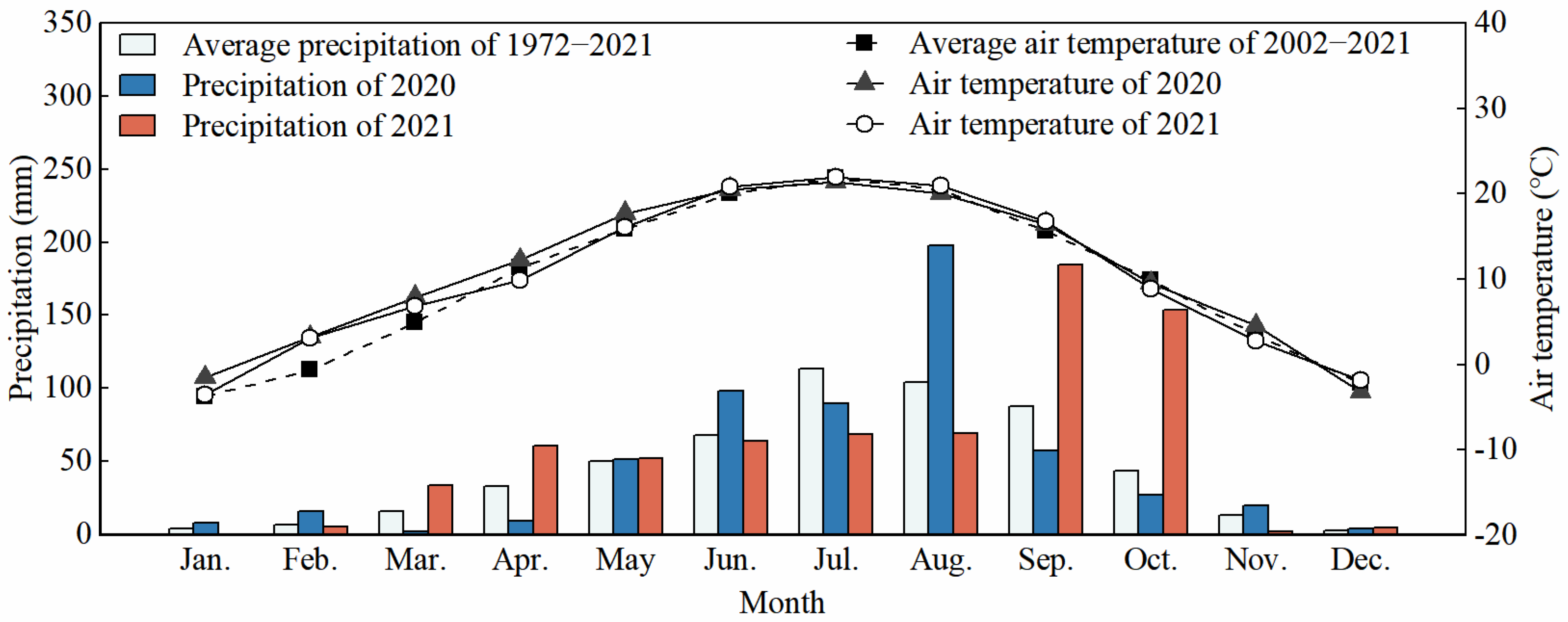
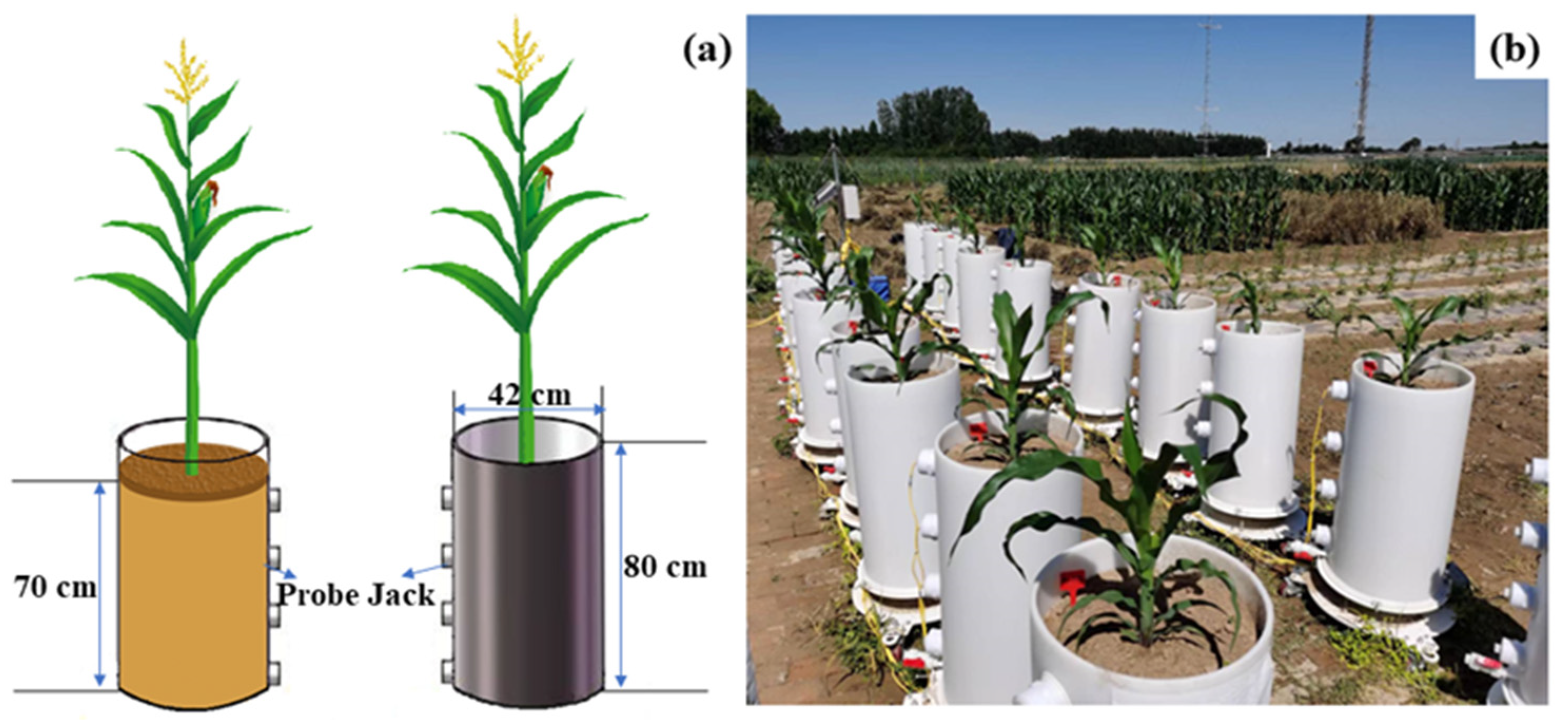
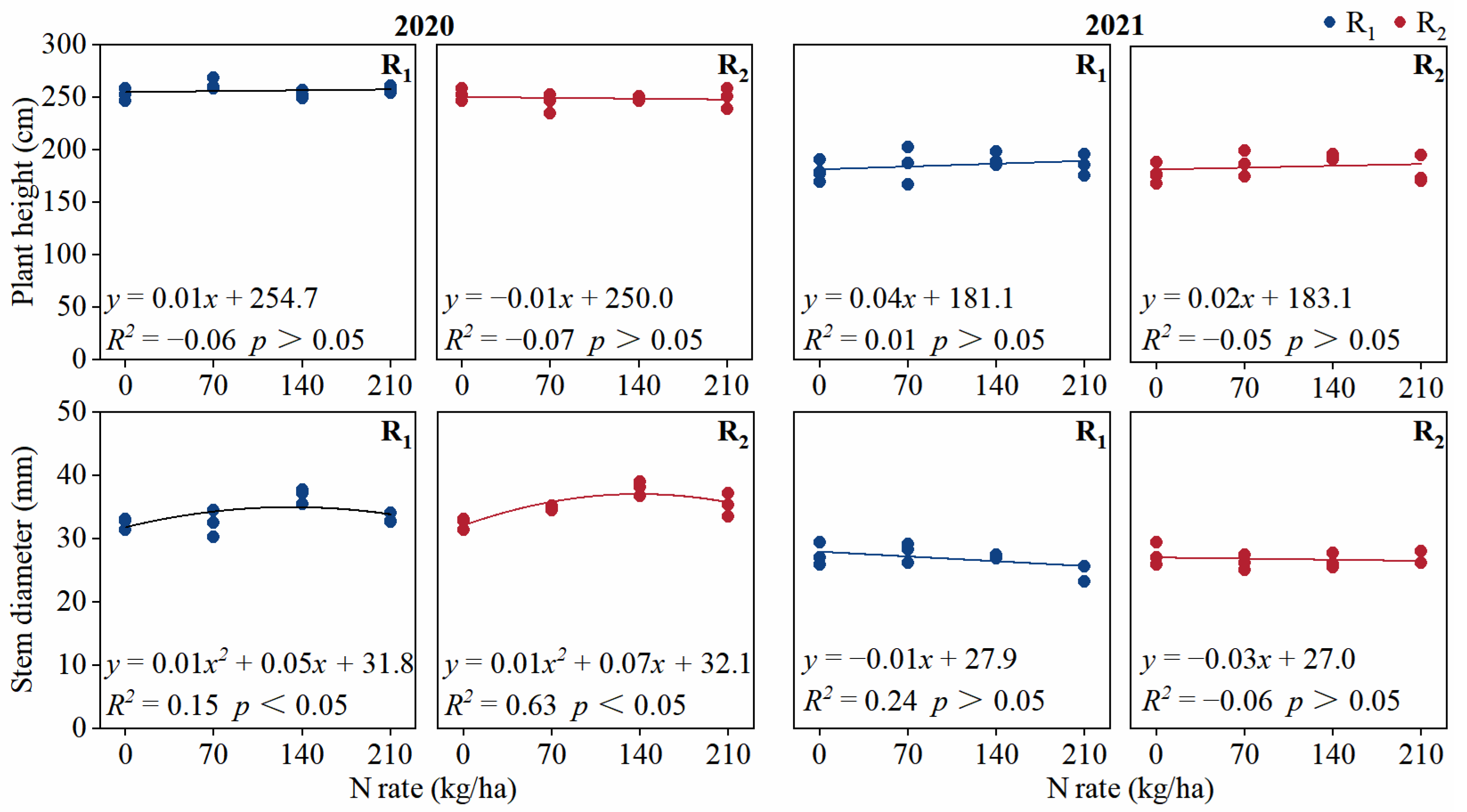

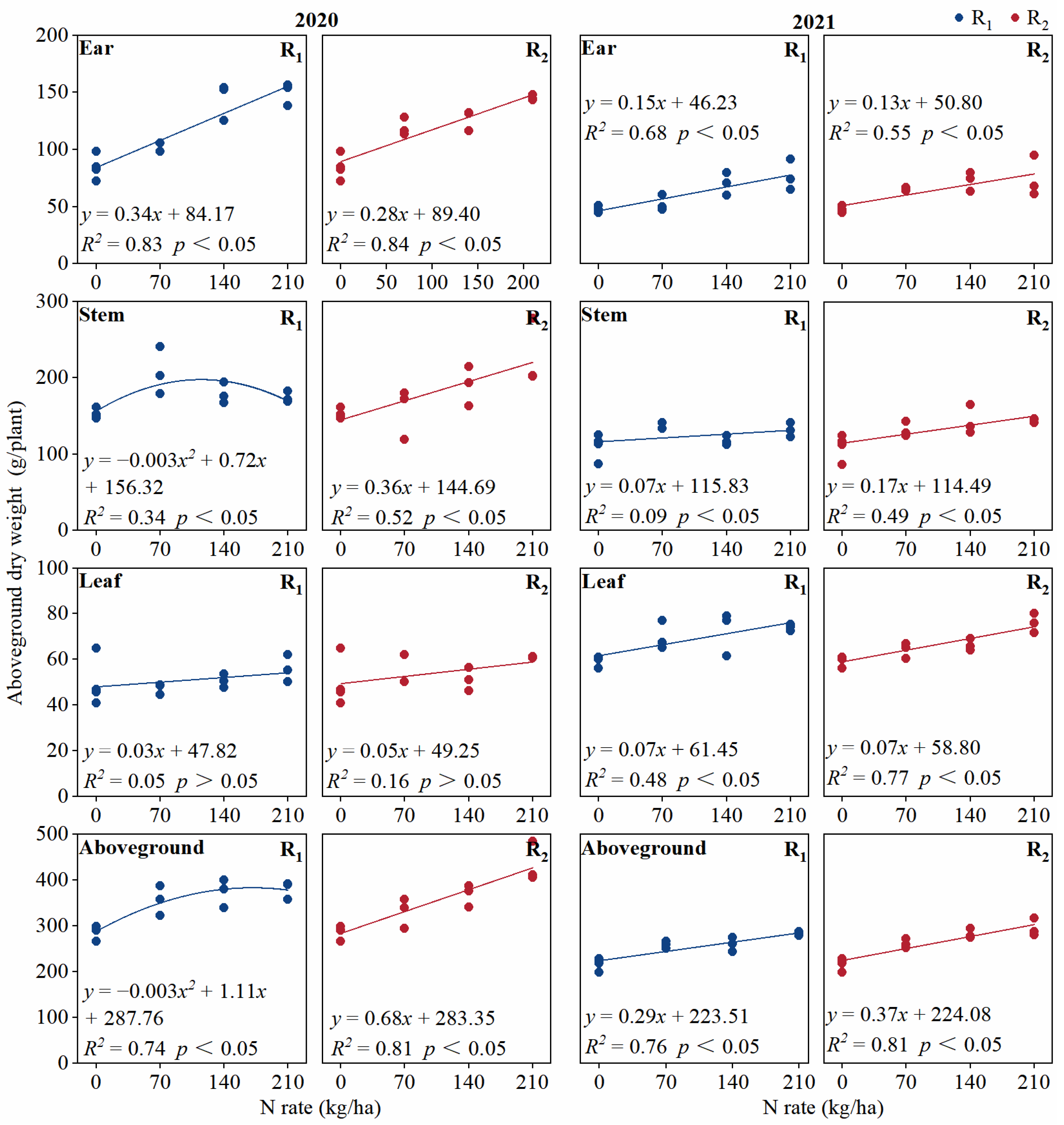

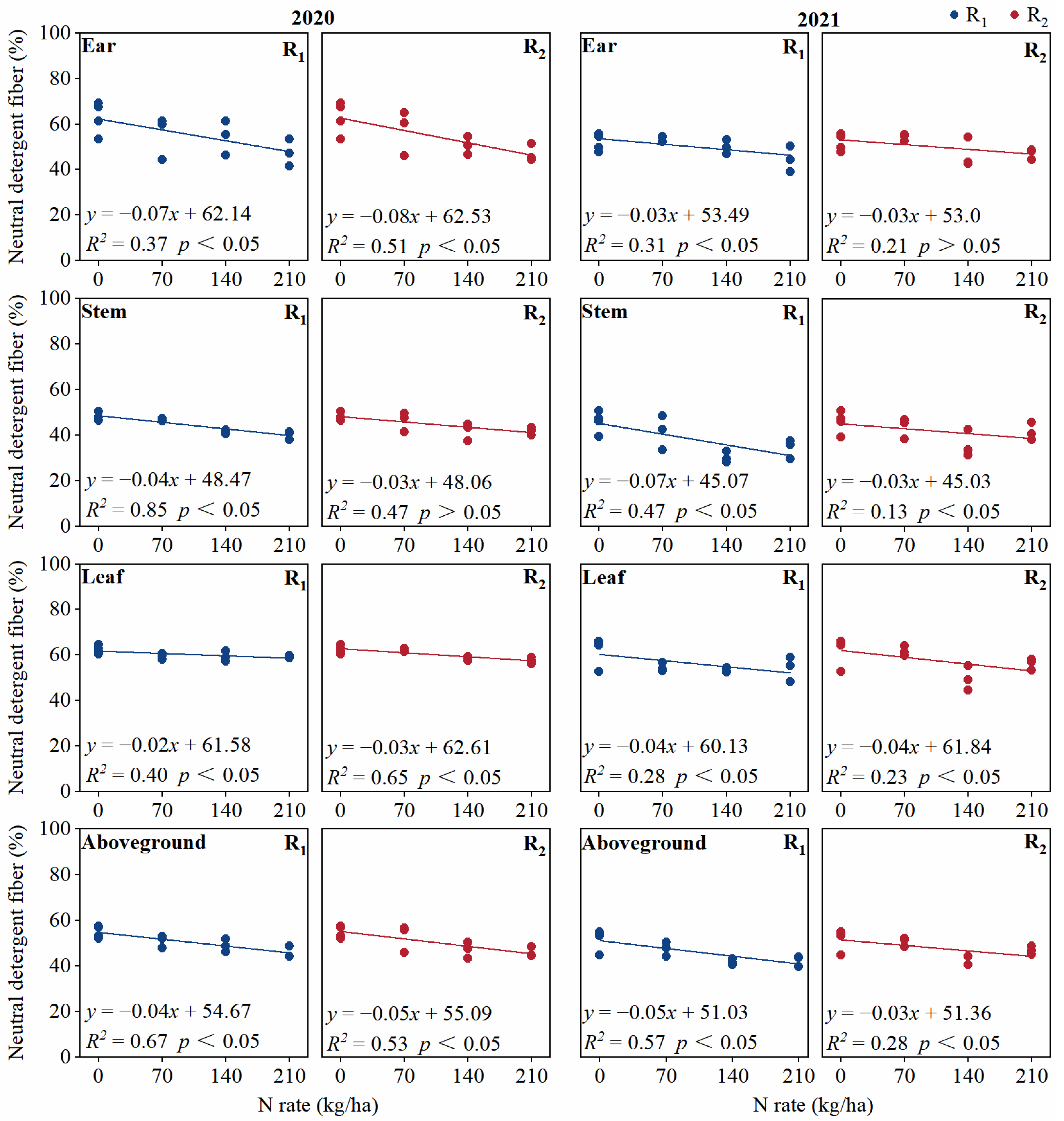
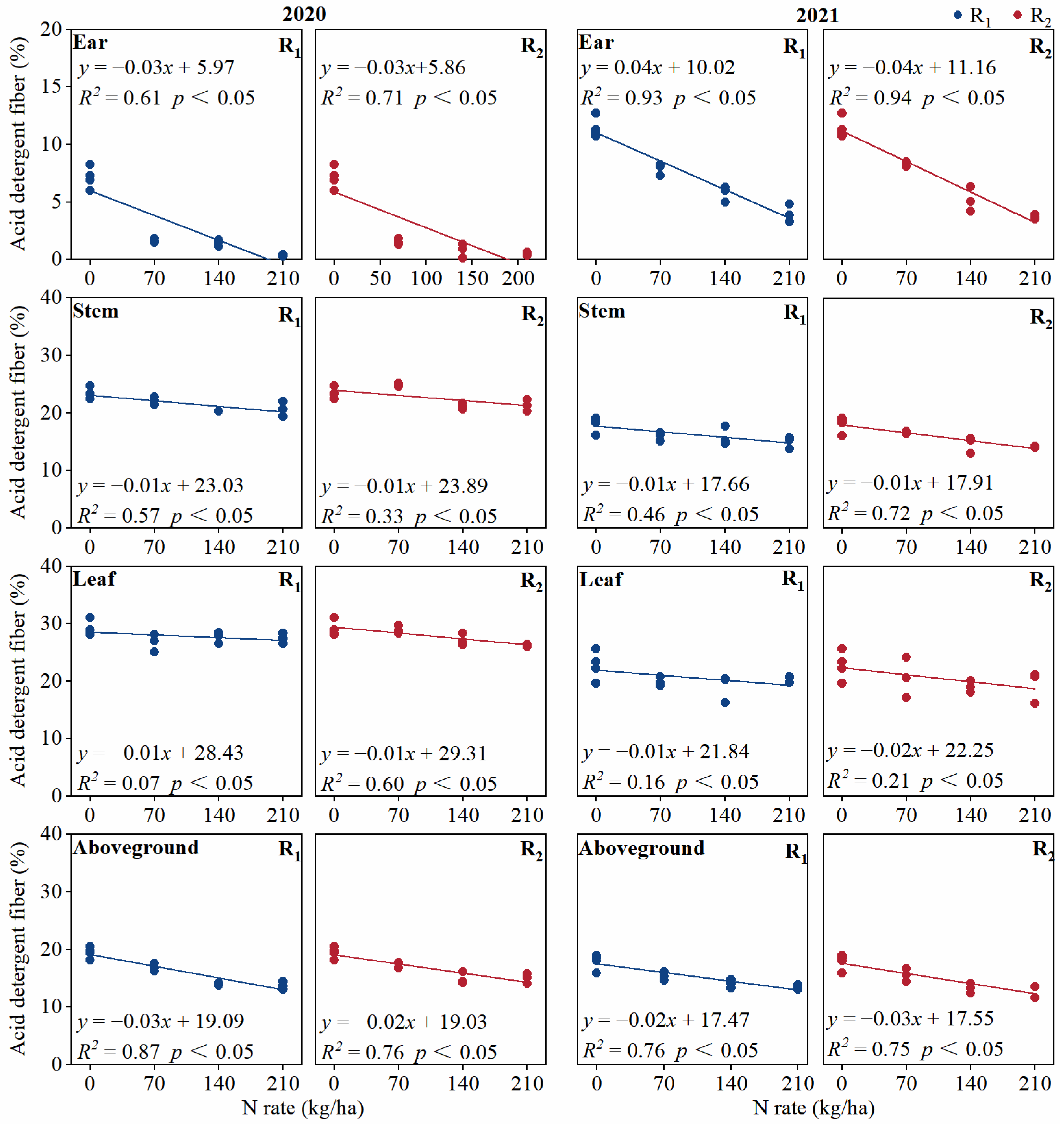

| Bulk Density (g/cm3) | Organic Matter (g/kg) | Total N (g/kg) | Nitrate N (mg/kg) | Ammonium N (mg/kg) | Available P (mg/kg) | Available K (mg/kg) | Field Capacity % | pH |
|---|---|---|---|---|---|---|---|---|
| 1.25 | 14.5 | 0.8 | 19.6 | 0.7 | 5.7 | 141.0 | 25.9 | 8.2 |
| Treatment | 2020 | 2021 | ||
|---|---|---|---|---|
| Plant Height (cm) | Stem Diameter (mm) | Plant Height (cm) | Stem Diameter (mm) | |
| N rate | ||||
| N0 | 254.4 a | 32.4 b | 179.2 a | 26.7 a |
| N70 | 253.3 a | 33.6 b | 187.2 a | 27.1 a |
| N140 | 250.4 a | 37.4 a | 192.9 a | 26.8 a |
| N210 | 253.4 a | 34.3 b | 183.6 a | 25.8 a |
| N ratio | ||||
| 2:8 | 257.4 a | 34.2 b | 187.4 a | 26.7 a |
| 4:6 | 247.3 b | 36.1 a | 188.4 a | 26.5 a |
| N rate | p > 0.05 | p < 0.01 | p > 0.05 | p > 0.05 |
| N ratio | p < 0.01 | p < 0.05 | p > 0.05 | p > 0.05 |
| Rate × Ratio | p > 0.05 | p > 0.05 | p > 0.05 | p > 0.05 |
| Year | Treatment | Aboveground Fresh Weight (g/Plant) | Aboveground Dry Weight (g/Plant) | ||||||
|---|---|---|---|---|---|---|---|---|---|
| Leaf | Stem | Ear | Whole Plant | Leaf | Stem | Ear | Whole Plant | ||
| 2020 | N rate | ||||||||
| N0 | 99.4 d | 544.9 c | 364.3 b | 1008.6 c | 49.5 b | 152.2 b | 84.6 c | 286.3 c | |
| N70 | 112.5 c | 588.4 b | 451.7 a | 1152.6 b | 50.7 ab | 182.4 ab | 110.1 b | 343.2 b | |
| N140 | 124.0 b | 631.8 a | 511.0 a | 1266.8 a | 50.9 ab | 184.8 ab | 135.4 a | 371.2 ab | |
| N210 | 136.9 a | 604.7 ab | 523.7 a | 1265.3 a | 58.4 a | 201.2 a | 147.4 a | 407.0 a | |
| N ratio | |||||||||
| 2:8 | 123.5 a | 609.1 a | 536.6 a | 1269.2 a | 51.2 a | 187.2 a | 131.5 a | 369.9 a | |
| 4:6 | 125.4 a | 607.5 a | 454.4 b | 1187.3 b | 55.5 a | 191.7 a | 130.5 a | 377.7 a | |
| N rate | p < 0.01 | p < 0.01 | p < 0.01 | p < 0.01 | p > 0.05 | p > 0.05 | p < 0.01 | p < 0.01 | |
| N ratio | p > 0.05 | p > 0.05 | p < 0.05 | p < 0.05 | p > 0.05 | p > 0.05 | p > 0.05 | p > 0.05 | |
| Rate × Ratio | p > 0.05 | p > 0.05 | p > 0.05 | p > 0.05 | p > 0.05 | p < 0.05 | p < 0.05 | p > 0.05 | |
| 2021 | N rate | ||||||||
| N0 | 88.3 c | 348.3 c | 172.0 d | 608.6 d | 59.4 c | 110.3 b | 47.5 c | 217.2 c | |
| N70 | 114.9 b | 444.6 b | 283.5 c | 843.0 c | 67.0 b | 134.0 a | 58.8 bc | 259.8 b | |
| N140 | 133.2 b | 486.4 b | 354.4 b | 974.0 b | 69.3 ab | 130.5 a | 71.3 ab | 271.1 ab | |
| N210 | 167.0 a | 581.7 a | 395.2 a | 1144.0 a | 74.9 a | 138.0 a | 75.8 a | 288.7 a | |
| N ratio | |||||||||
| 2:8 | 146.7 a | 501.8 a | 360.2 a | 1008.7 a | 72.0 a | 128.3 a | 66.6 a | 266.9 b | |
| 4:6 | 130.1 b | 506.7 a | 328.6 b | 965.3 b | 68.8 a | 140.0 a | 70.7 a | 279.5 a | |
| N rate | p < 0.01 | p < 0.01 | p < 0.01 | p < 0.01 | p < 0.01 | p < 0.05 | p < 0.01 | p < 0.01 | |
| N ratio | p < 0.05 | p > 0.05 | p < 0.05 | p < 0.05 | p > 0.05 | p > 0.05 | p > 0.05 | p < 0.05 | |
| Rate × Ratio | p > 0.05 | p > 0.05 | p > 0.05 | p > 0.05 | p > 0.05 | p < 0.05 | p > 0.05 | p > 0.05 | |
| Treatment | CP Content (%) in 2020 | CP Content (%) in 2021 | ||||||
|---|---|---|---|---|---|---|---|---|
| Leaf | Stem | Ear | Whole Plant | Leaf | Stem | Ear | Whole Plant | |
| N rate | ||||||||
| N0 | 8.7 b | 1.3 a | 10.3 b | 5.2 c | 6.0 b | 1.2 c | 8.4 b | 4.1 c |
| N70 | 9.8 a | 1.2 a | 10.5 b | 5.4 bc | 8.5 a | 1.9 b | 9.1 b | 5.2 b |
| N140 | 10.9 a | 1.4 a | 10.9 b | 6.2 ab | 9.6 a | 2.4 b | 10.9 a | 6.5 a |
| N210 | 10.4 a | 1.3 a | 12.4 a | 6.7 a | 9.8 a | 3.0 a | 11.7 a | 7.0 a |
| N ratio | ||||||||
| 2:8 | 10.8 a | 1.4 a | 12.1 a | 6.5 a | 9.9 a | 2.7 a | 11.0 a | 6.7 a |
| 4:6 | 9.8 a | 1.2 b | 10.4 b | 5.7 b | 8.7 b | 2.2 b | 10.2 b | 5.8 b |
| N rate | p < 0.05 | p > 0.05 | p < 0.05 | p < 0.05 | p < 0.01 | p < 0.01 | p < 0.01 | p < 0.01 |
| N ratio | p > 0.05 | p < 0.05 | p < 0.01 | p < 0.01 | p < 0.05 | p < 0.01 | p < 0.05 | p < 0.05 |
| Rate × Ratio | p > 0.05 | p > 0.05 | p > 0.05 | p < 0.05 | p < 0.01 | p < 0.05 | p > 0.05 | p > 0.05 |
| Year | Treatment | NDF (%) | ADF (%) | ||||||
|---|---|---|---|---|---|---|---|---|---|
| Leaf | Stem | Ear | Whole Plant | Leaf | Stem | Ear | Whole Plant | ||
| 2020 | N rate | ||||||||
| N0 | 62.2 a | 48.2 a | 62.8 a | 54.9 a | 29.1 a | 23.2 a | 7.1 a | 19.4 a | |
| N70 | 60.8 ab | 46.4 a | 56.2 ab | 51.9 ab | 27.8 ab | 23.5 a | 1.6 b | 17.0 b | |
| N140 | 58.7 bc | 41.7 b | 52.4 b | 48.0 bc | 27.3 b | 20.7 b | 1.1 b | 14.5 c | |
| N210 | 58.2 c | 41.0 b | 47.2 b | 45.8 c | 26.8 b | 21.0 b | 0.4 c | 14.3 c | |
| N ratio | |||||||||
| 2:8 | 59.2 a | 42.8 a | 52.3 a | 48.5 a | 27.2 a | 21.0 b | 1.1 a | 14.8 b | |
| 4:6 | 59.3 a | 43.3 a | 51.6 a | 48.6 a | 27.4 a | 22.4 a | 0.9 a | 15.7 a | |
| N rate | p < 0.01 | p < 0.01 | p < 0.05 | p < 0.01 | p > 0.05 | p < 0.01 | p < 0.01 | p < 0.01 | |
| N ratio | p > 0.05 | p > 0.05 | p > 0.05 | p > 0.05 | p > 0.05 | p < 0.01 | p > 0.05 | p < 0.05 | |
| Rate × Ratio | p < 0.05 | p > 0.05 | p > 0.05 | p > 0.05 | p < 0.05 | p > 0.05 | p > 0.05 | p > 0.05 | |
| 2021 | N rate | ||||||||
| N0 | 62.0 a | 45.9 a | 51.9 ab | 51.7 a | 22.7 a | 18.0 a | 11.4 a | 17.9 a | |
| N70 | 58.1 ab | 42.5 ab | 54.0 a | 49.1 a | 20.2 ab | 16.3 b | 8.1 b | 15.5 b | |
| N140 | 51.3 c | 33.0 c | 48.3 bc | 41.7 b | 19.0 b | 15.2 bc | 5.5 c | 13.6 c | |
| N210 | 55.1 bc | 37.9 bc | 45.8 c | 44.6 b | 19.8 b | 14.5 c | 3.8 d | 13.1 c | |
| N ratio | |||||||||
| 2:8 | 53.9 a | 35.3 a | 49.4 a | 43.9 b | 19.7 a | 15.5 a | 5.9 a | 14.2 a | |
| 4:6 | 55.8 a | 40.3 a | 49.3 a | 46.4 a | 19.6 a | 15.1 a | 5.7 a | 13.9 a | |
| N rate | p > 0.05 | p < 0.01 | p < 0.01 | p < 0.01 | p > 0.05 | p < 0.01 | p < 0.01 | p < 0.01 | |
| N ratio | p > 0.05 | p > 0.05 | p > 0.05 | p < 0.05 | p > 0.05 | p > 0.05 | p > 0.05 | p > 0.05 | |
| Rate × Ratio | p > 0.05 | p > 0.05 | p > 0.05 | p > 0.05 | p > 0.05 | p > 0.05 | p > 0.05 | p > 0.05 | |
| Treatment | 2020 | 2021 | ||||
|---|---|---|---|---|---|---|
| DMI (%) | DDM (%) | RFV (%) | DMI (%) | DDM (%) | RFV (%) | |
| N rate | ||||||
| N0 | 2.3 c | 73.8 c | 132.6 b | 2.3 b | 75.0 c | 135.9 b |
| N70 | 2.4 bc | 75.7 b | 142.5 b | 2.5 b | 76.9 b | 145.9 b |
| N140 | 2.6 ab | 77.6 a | 158.6 a | 2.9 a | 78.3 a | 174.6 a |
| N210 | 2.8 a | 77.8 a | 167.4 a | 2.7 a | 78.7 a | 164.8 a |
| N ratio | ||||||
| 2:8 | 2.6 a | 77.3 a | 156.5 a | 2.7 a | 77.8 a | 165.7 a |
| 4:6 | 2.6 a | 76.7 b | 155.9 a | 2.6 a | 78.1 a | 157.8 a |
| N rate | p < 0.01 | p < 0.01 | p < 0.01 | p < 0.01 | p < 0.01 | p < 0.01 |
| N ratio | p > 0.05 | p < 0.05 | p > 0.05 | p > 0.05 | p > 0.05 | p > 0.05 |
| Rate × Ratio | p > 0.05 | p > 0.05 | p > 0.05 | p > 0.05 | p > 0.05 | p > 0.05 |
| Treatment | 2020 | 2021 | ||||
|---|---|---|---|---|---|---|
| WUE (g/kg) | RE (%) | PFP (kg/kg) | WUE (g/kg) | RE (%) | PFP (kg/kg) | |
| N rate | ||||||
| N0 | 4.3 c | 5.4 c | ||||
| N70 | 5.1 b | 24.4 a | 179.5 a | 6.5 b | 31.7 a | 135.9 a |
| N140 | 5.6 b | 27.1 a | 97.1 b | 6.9 b | 29.3 a | 70.9 b |
| N210 | 6.6 a | 26.8 a | 70.9 c | 7.5 a | 25.6 a | 50.3 c |
| N ratio | ||||||
| 2:8 | 5.6 a | 30.4 a | 116.7 a | 6.8 b | 32.8 a | 84.1 a |
| 4:6 | 5.9 a | 21.8 b | 115.0 a | 7.1 a | 24.9 b | 87.3 a |
| N rate | p < 0.01 | p > 0.05 | p < 0.01 | p < 0.01 | p > 0.05 | p < 0.01 |
| N ratio | p > 0.05 | p < 0.05 | p > 0.05 | p < 0.05 | p < 0.01 | p > 0.05 |
| Rate × Ratio | p < 0.05 | p > 0.05 | p > 0.05 | p < 0.05 | p > 0.05 | p > 0.05 |
Disclaimer/Publisher’s Note: The statements, opinions and data contained in all publications are solely those of the individual author(s) and contributor(s) and not of MDPI and/or the editor(s). MDPI and/or the editor(s) disclaim responsibility for any injury to people or property resulting from any ideas, methods, instructions or products referred to in the content. |
© 2023 by the authors. Licensee MDPI, Basel, Switzerland. This article is an open access article distributed under the terms and conditions of the Creative Commons Attribution (CC BY) license (https://creativecommons.org/licenses/by/4.0/).
Share and Cite
Ma, R.; Jiang, C.; Shou, N.; Gao, W.; Yang, X. An Optimized Nitrogen Application Rate and Basal Topdressing Ratio Improves Yield, Quality, and Water- and N-use Efficiencies for Forage Maize (Zea mays L.). Agronomy 2023, 13, 181. https://doi.org/10.3390/agronomy13010181
Ma R, Jiang C, Shou N, Gao W, Yang X. An Optimized Nitrogen Application Rate and Basal Topdressing Ratio Improves Yield, Quality, and Water- and N-use Efficiencies for Forage Maize (Zea mays L.). Agronomy. 2023; 13(1):181. https://doi.org/10.3390/agronomy13010181
Chicago/Turabian StyleMa, Renshi, Congze Jiang, Na Shou, Wei Gao, and Xianlong Yang. 2023. "An Optimized Nitrogen Application Rate and Basal Topdressing Ratio Improves Yield, Quality, and Water- and N-use Efficiencies for Forage Maize (Zea mays L.)" Agronomy 13, no. 1: 181. https://doi.org/10.3390/agronomy13010181
APA StyleMa, R., Jiang, C., Shou, N., Gao, W., & Yang, X. (2023). An Optimized Nitrogen Application Rate and Basal Topdressing Ratio Improves Yield, Quality, and Water- and N-use Efficiencies for Forage Maize (Zea mays L.). Agronomy, 13(1), 181. https://doi.org/10.3390/agronomy13010181




